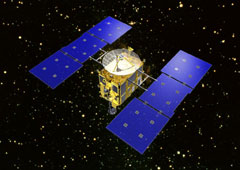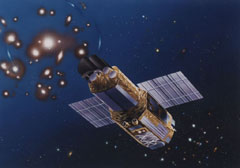 |
 |


Five organizations that are involved in the International Space Station (ISS) met at a summit meeting last February; at a Paris aviation show in June a meeting was held of all ISS participating countries; and in October, all the heads of space institutions gathered at the International Astronautical Congress (IAC) in Fukuoka. On all these occasions, I had the opportunity to meet other representatives individually, and to hear their requests and comments.
The request I heard most often was for collaborative research. Since space projects take a great amount of time, it is imperative to plan carefully and collaborate with other countries, following a clear vision; for example, how much time will be spent on the development of a new satellite, or what observation device one participant or another will provide. If any country fails to complete its tasks, the project will fall apart. When it comes to space research and development, I have a sense that the spirit of international collaboration is very strong.
As far as the International Space Station is concerned, Japan's role is valued highly, for two reasons: we are responsible for 12.8% of the total expense, which is a significant contribution, and soon we will launch our own experiment module.
I was impressed by the fact that the international assessment of Japanese astronautical science has actually been higher than expected as well. Japan is recognized for steadily focusing on its strengths while working within a limited budget, and for continuing to work without the spur of competition on research that other countries are not doing. Hayabusa is a good example, and so is the X-ray astronomy satellite Suzaku, which was launched last July, since X-ray astronomy is one of Japan's areas of strength.
Hayabusa has a particularly strong international reputation. Its mission has been covered by many foreign media, and I have received a lot of congratulatory correspondence from around the world. Although Hayabusa has had some problems, I think that arriving safely at Itokawa and taking images of the asteroid was quite a success. I am anticipating that later data analysis will reveal new discoveries. Hayabusa has been a great success.
|


Asteroid Sample-return Spacecraft "HAYABUSA" (MUSES-C)


Scientific Satellite "SUZAKU" (ASTRO-EII)
|

The biggest concern is the delay in the construction of the International Space Station (ISS), caused by the space shuttle Columbia accident and other factors. In 2004 the United States announced a new space policy, which included renewed support for the ISS program. The major change announced in the policy was the planned retirement of the space shuttle. The ISS is scheduled to be completed by 2010, but the number of planned space shuttle flights has been cut from 28 to 18. Instead, NASA is planning to use Russian rockets to supply the ISS, and also looking into the possibility of hiring a private U.S. company to launch transfer vehicles. This indicates that there is no change in the United States' intention to complete the ISS, but that there will be some changes in their approach.
In Japan and Europe, there are no specific policy changes towards the ISS.
Japan is preparing for the launch of its experiment module, Kibo, in 2007 or 2008. A Japanese astronaut will accompany Kibo for an extended stay on the ISS, to assemble the module and prepare it for experiments. An astronaut's mission is not just getting to space, but also successfully conducting experiments on behalf of scientists.
Since supplying Kibo will be Japan's responsibility, we are working on completing the development of the HTV (H-II Transfer Vehicle) by about 2009. Considering the reduction in the number of space shuttle launches, there is a possibility that the U.S. will use the HTV for its supply flights. Once the ISS is completed, it will be staffed by six astronauts. Naturally, food, drink and oxygen supply will be crucial, so we must ensure the successful development of our own transfer vehicle. |


Japanese Experiment Module (JEM) "KIBO"


H-II Transfer Vehicle
|

|
 |
 |

